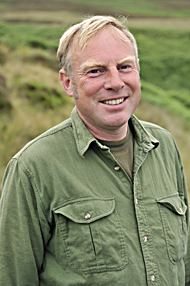
| HOME |
| PROJECT DETAILS |
| PROJECT ADMINSTRATION |
| JOINT RAPTOR STUDY |
| THE MOOR |
| THE GROUSE |
| THE RAPTORS |
| OTHER WILDLIFE |
| DIVERSIONARY FEEDING |
| GAMEKEEPING |
| WILDLIFE SURVEYS |
| NEWS |
| CONTACT |
| PHOTO GALLERY |
Previous Diaries
| Simon Lester's gamekeeping diary |
May 2011 WHILE most of the country basked in sunshine, the weather during May at Langholm has been the complete opposite. April lulled us into a false sense of security because it was so dry and warm. The king cups, ladies' smock, wood anemones and primroses were all even more stunning than usual, as the grass was stunted and the flowers were able to bloom in all their glory without being battered by rain. This made such a busy time of the year that little bit more bearable. Spring is always a busy time for gamekeepers, particularly as foxes seem to be cubbing earlier this spring, and earths need seeking out. We've all noticed an increase in badger activity, with some taking over fox earths, which has made finding the foxes' new locations even more of a laborious task. The spring grouse counts were very disappointing. The grouse that we do have are in good fettle and the worm burdens are low. But sadly and despite all our hard work, the numbers are down (though not statistically according to the scientists) on what we had last spring. Foxes have not accounted for many grouse kills over the winter. Indeed, the scientific monitoring of fox and mustelid numbers suggests that they are at low levels. We are, however, concerned about increasing raptor predation, and the scientists have begun assessing the impact they might be having on the grouse. A Masters student will be monitoring buzzard nests within the Project area this year. The work will include collecting prey remains from around the nest site and setting up nest cameras so that we can see what food the adult birds bring back into the nest. At present, 16 buzzard nests have been located on and around the moor. We currently have two hen harrier nests. The eggs in one nest have hatched and the adult birds are taking the diversionary food with gusto. We think that the hen is one of the girls that nested here last year, as she took the pre-nesting food, too. The second nest has five eggs in it. Another hen is floating about along with a juvenile cock, but the nesting period will quickly run out if she doesn't settle soon. As far as the satellite tagged harriers are concerned, our remaining cock from last year's offspring that over-wintered in Spain, has returned to Scotland and settled in the Leadhills area. This male's remarkable journey has surprised and enlightened many. We hope to be able to give more people an insight into hen harrier behaviour by posting details of the birds' movements on this website. However, there is a lot more happening on the moor at the moment aside from what's going on with the grouse and the hen harriers. The short-eared, long-eared and barn owls are taking full advantage of this record vole year. There are also at least four pairs of merlin. I have seen one brood of lapwings so far, but I've also spotted a couple of sitting females at some new sites on large areas that we have burnt, sprayed and chopped to aid heather re-generation. I'm really pleased that these areas seem to have attracted more than our usual few pairs of lapwings. I think that there are more curlews this year as well and I was lucky enough to find a nest containing four eggs (see photo), just a few yards from a quad track. These waders are still at low numbers from what they were years ago, and I can't help worrying about those eggs now that the ravens have fledged and are scouring the moor in family groups. Despite the promising start to the spring, the weather in May has been terrible, with persistent rain and even gales. You don't expect to regularly get stuck in mud in May, with some places simply being impassable. This has made all our varied jobs, such as setting up cameras on harrier nests and catching grouse chicks to monitor chicks, trickier than usual.I saw my first grouse brood on 17 May. The radio-tracked hens had good clutches and most hatched their eggs successfully, but the numbers can only have been reduced by the cold and amount of rain, as this also reduces numbers of all-important insects that the chicks need to eat during the first few days of life. However, casting my mind back to sunny April, I did see a sight that I have always wanted to see — dancing adders. I saw three males wrapped around a female; but I think must have danced all night, as they all seemed to taking a well-earned rest. |
